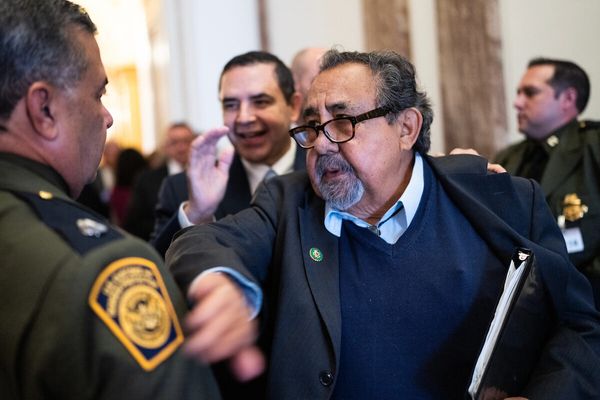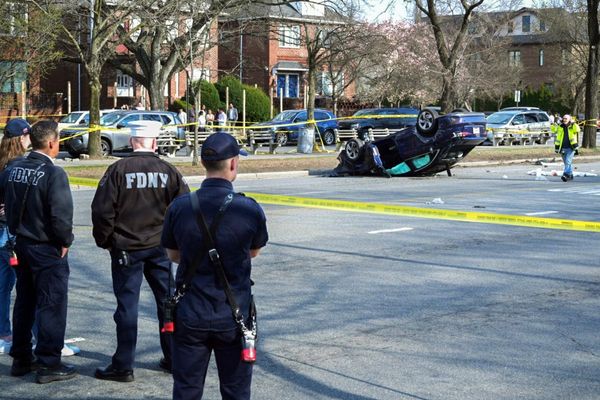The announcements came in a flurry as soon as the calendar flipped to July one year ago.
Miami quarterback D’Eriq King was among the first college athletes to capitalize on the use of his name, image and likeness, signing a deal with a moving company worth about $20,000. Wisconsin quarterback Graham Mertz and Oklahoma quarterback Spencer Rattler tweeted out their new personal logos, showing they were open for business. Hanna and Haley Cavinder, twin basketball players from Fresno State who were mostly unknown to the sports world aside from their massive social media following, suddenly found themselves posing in New York City promoting a mobile technology company and a whey protein brand.
It was all so … fun and seemingly innocent — and long overdue. When college sports’ NIL era began, businesses were paying current athletes either to reap the benefits from their fame or to create a buzz within the industry as a bold entrant into the new advertising space.
Then boosters started making their moves. Nearly a year later, Ohio State coach Ryan Day had to tell the local business leaders that the Buckeyes would need around $13 million yearly to compensate his five-star-studded roster. “Collectives” of donors across the country have tossed their riches together into funds, and the more brazen among them have reportedly offered six- and seven-figure agreements to high school players and college athletes who have entered the transfer portal. This alleged assault on the NCAA’s long-held rule that recruits could not be induced to attend a school by the promise of financial gain forced the association to threaten punishment in the coming year.
How did we get here? And where are we going? The upcoming one-year anniversary of this momentous change feels like a good time to explore.
What was NIL supposed to be and what is it today?
I have been writing about college athletes and the NIL since before the 2014 Ed O’Bannon v. NCAA trial. As Americans, we all have rights to use our NIL to make money, but college athletes did not due to the NCAA’s amateurism rules that were meant to differentiate between college and pro sports — and keep money in the pockets of the schools. O’Bannon did not appreciate the NCAA being able to use his NIL in classic broadcasts or video games without him seeing a cut of the profits. He was right to step forward.
This year, thousands of athletes have made varying amounts of money off legitimate use of NIL. The confusion has come when collectives are throwing large sums of money at football and men’s basketball players under the guise of NIL, when it is hard to imagine an exchange of services that could possibly equate to an amount like the reported $8 million deal a Tennessee collective gave to quarterback Nico Iamaleava of Long Beach Poly to secure his commitment.
In these cases, “NIL” is functioning as pay for play. I have no problem with college athletes being paid by schools or donors for immense gifts on the field, as long as all competing schools are playing by the same rules, which certainly does not appear to be the case across the Power Five.
“There is athlete-driven NIL, and there is athletics-driven NIL,” says Blake Lawrence, the founder of Opendorse, an app that connects athletes with brands, donors and fans. “Athlete-driven is student-athletes getting paid for social media promotions, merchandise sales, camps, clinics, appearances, where athletes are acting entrepreneurially. Athletics-driven is really the sponsors and donors in a certain market that are already supporting [the athletic department] in that market compensating student-athletes that happen to play their favorite sport at their favorite school.
“July was purely athlete-driven NIL. Brands compensating athletes at generally market rate. In August, we saw the first donor payment. It was the same outcome — this individual is paying an athlete for NIL activity — but maybe there’s an extra zero on the payment.”
It would be very hard for NCAA enforcement to find an issue with such a payment made through Opendorse, which requires evidence of the athlete completing the job before they can be compensated and has not processed a payment to a high school or transfer athlete.
“Illegitimate agreements are still handshake deals or off-platform transactions,” Lawrence says.
Can the NCAA actually enforce its new rules that focus on booster activity?
To me, it’s pretty easy to tell when something is NIL or “NIL,” but the NCAA is going to have its hands full finding evidence to differentiate.
“There’s no justification for the rule if it’s not going to be enforced, and sitting here a year in we haven’t seen a single enforcement, and we may never,” says Darren Heitner, a sports attorney who has advised many athletes, schools and collectives.
On July 1, 2021, Florida donor Eddie Rojas reached out to Heitner about helping to start the first known booster fund, which they named the “Gator Collective.” The term stuck as similar groups popped up nationwide. Heitner says Rojas wanted to comply with both Florida’s state law and the NCAA’s interim NIL policy.
“It’s a lot more than simply feeding athletes money, and there’s some true deliverables that the athletes are providing,” Heitner says. “We started to see larger donations being made over time to the collective and then not so long ago a creation of a separate organization with ‘Gator Guard,’ very powerful individuals pooling their resources with a minimum contribution of a million dollars. So we saw the model change over time, and that happened across the country.”
Donors have some workarounds to avoid NCAA scrutiny. Contracts don’t state that an athlete has to be enrolled at a certain school, but the contract would obviously have to be fulfilled within the vicinity of campus.
Also, collectives like the “Champions Circle” at Michigan have sprouted up with the promise to operate compliantly. Groups of donors who don’t want to be as brazen as others by directly contacting recruits or their families can still make it publicly known how much money they’ve raised for current athletes and what the general plans are for players to cash in.
What happens if an athletic department does not want a collective but donors start one anyway?
This is a question that will come up more often across the country in the second year of the NIL era. The answer is that schools can do nothing to stop their boosters from organizing and doing whatever they want, which will lead to a power struggle on many campuses.
“I would just expect there will be a collective in every Power Five market, whether the school wants it or not, and you will see schools provide a clear call to action to their fan base to support them through compliant NIL activities,” Lawrence says. “And trying to get those collectives, if they are going to be in town, to use the [proper] tools and understand the rules.”
Using Lawrence’s parlance, he expects the schools to direct fans to “athlete-driven” NIL marketplaces like Opendorse instead of working with collectives.
“At venues across the country, on the Jumbotron before the game, they will be educating everyone in attendance on the rules of NIL and how to support student-athletes today,” Lawrence says. “The schools have become more comfortable and understand they play a role in this.”
Of course, top donors might choose to continue playing their own game.
“You do have boosters who have made a lot of money in their careers and believe that no one is going to tell them what they can and can’t do,” Heitner says. “Furthermore, the athletic departments may feel reluctance to be very strong in their opinions toward these boosters because they are relied upon by those departments for their funding as well. That could change if the NCAA decides to punish any schools based on activities of their boosters.”
Where will USC and UCLA fit into the NIL landscape?
USC and UCLA donors have not announced collectives — yet. It feels like an inevitability, despite the schools’ efforts to separate themselves with their support of legitimate NIL activity.
UCLA provided training for every athlete before and shortly after the NIL rule changes, partnering with the business school and other campus resources with the goal of helping every Bruins athlete to make informed NIL decisions.
In April, UCLA announced it was creating Westwood Exchange, which allows businesses, donors, fans and alumni to register with the school so that they can connect with athletes seeking NIL deals that could include autograph sessions, private lessons in their respective sports, public appearances, athletic camps and social media promotion, among other possibilities. The initiative is geared toward small, local businesses that want to engage UCLA athletes and could be especially beneficial in landing deals for those who compete in lower-profile sports.
On June 15, USC announced an agreement with Stay Doubted, which calls itself “a modern-day media agency empowering the next generation of student-athletes and fans, to provide enhanced NIL services to its student-athletes.” The message was that the Trojans won’t need a collective to be competitive in NIL among all sports, not just football.
“What is important for the general reader to understand is that NIL has created a need for new positions within college athletic departments — not just one, but five, six, because of so much inbound demand,” Lawrence says. “Compliance offices are turning into talent agents and marketing agents, and reviewing agreements. This is outside of their experience. A sign that a school is truly committed to NIL is they are hiring full-time staffers or contractors that serve in a similar capacity.”
Says Heitner, who worked with USC on its Stay Doubted partnership: “I hear from athletes and their families often that they don’t feel they’re receiving competent representation. Surely the starting quarterback at USC is going to have experienced agents representing them, but what about the remainder of the athletes?”
How long until Stay Doubted and Westwood Exchange are joined by full-fledged USC and UCLA collectives?
Stay tuned.







